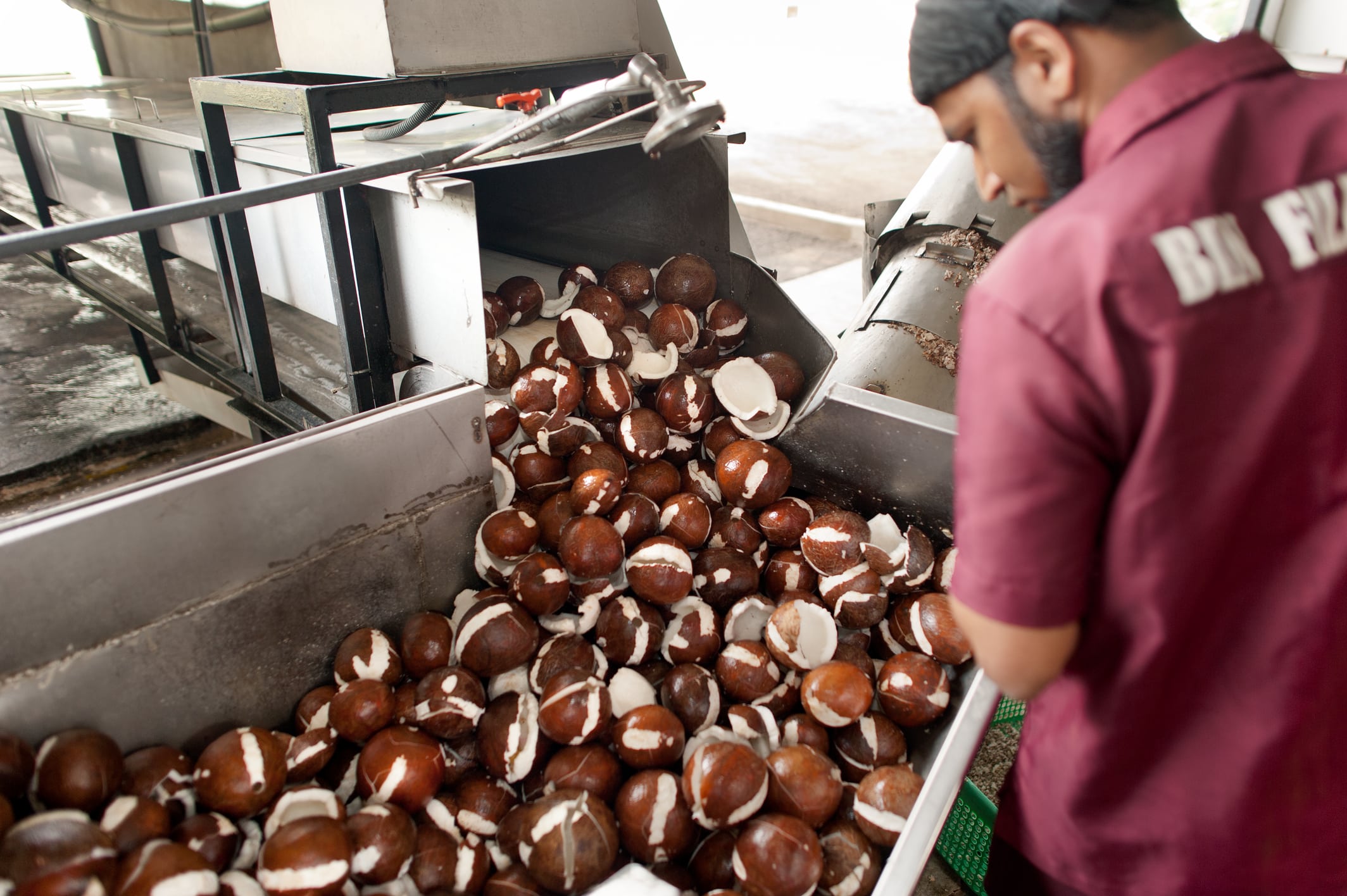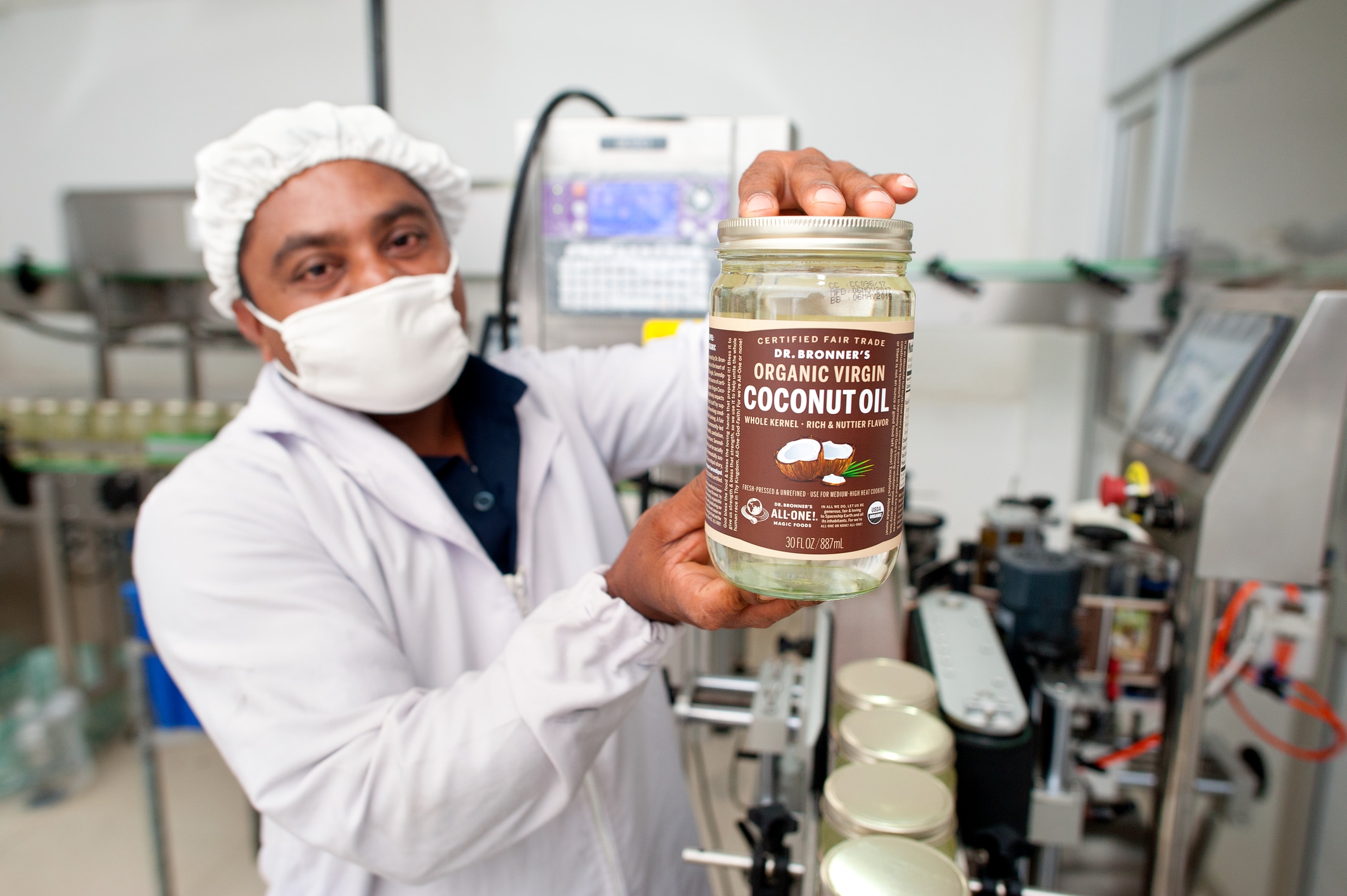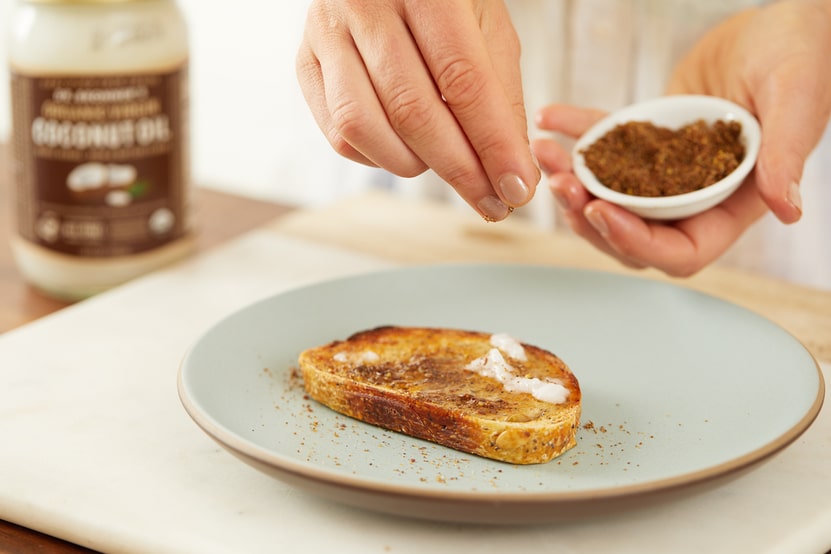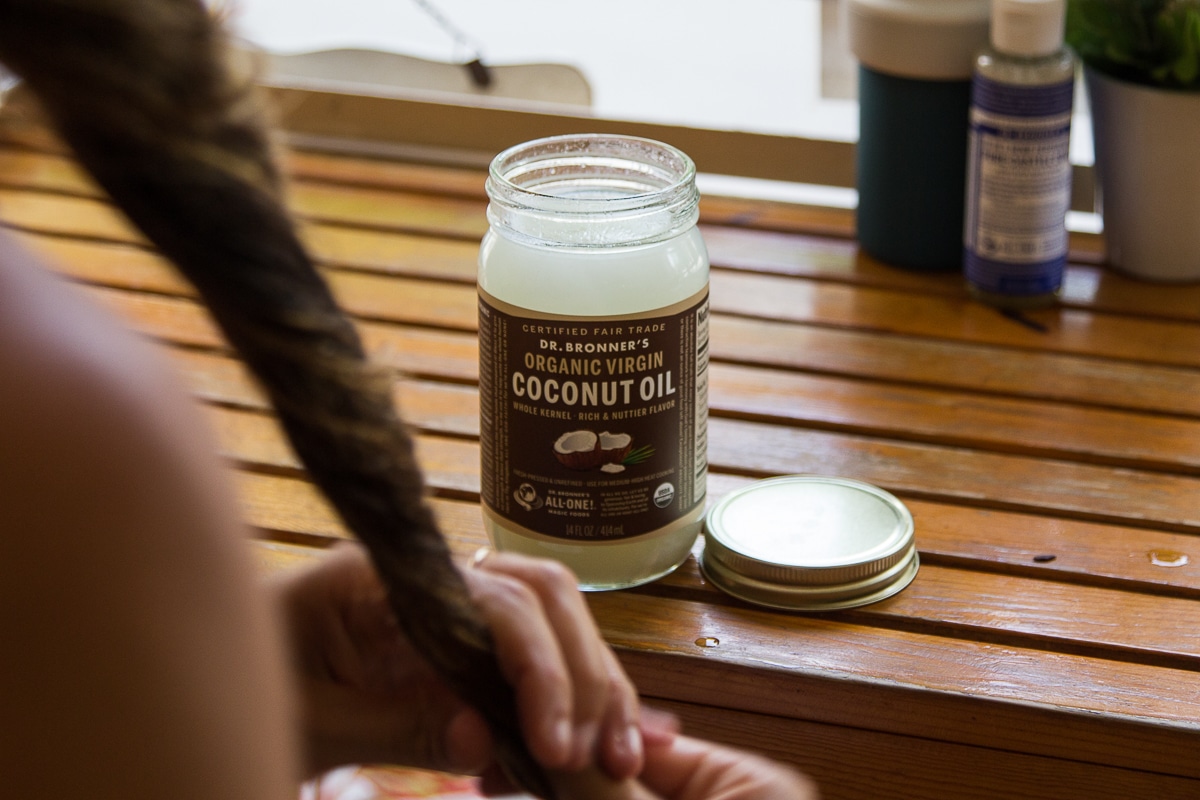Coconut oil usage guides can sound like a high stakes auction. 20 uses! 29 uses! 77 uses! 101 uses!
I didn’t try to count mine. I’ve incorporated coconut oil into so many of my kitchen and personal care routines, and I’m always learning more. Every use on this list below are ones I use myself or have seen used successfully. I can vouch for them all.
Click here to download the Coconut Oil Cheat Sheet.
Coconut oil has had its highs and lows in the court of public opinion. In food, it was blacklisted for a while because when hydrogenated, it contains trans fats. However, this is true of all oils when hydrogenated. Unprocessed, coconut oil does not contain trans fats. It was further blacklisted during the “all saturated fats are bad” era. However, coconut oil has shaken off these hindrances and has emerged as a strong contender among healthy oils and a great plant-based option. As with any oil, coconut oil should be consumed in moderation.
For cosmetic purposes, coconut oil also had a rocky road, becoming quite tangled up in “non-comedogenic” and its beautiful adjectival cousin, “comedogenicity.” These words were a marketer’s dream. They sound so authoritative and scientific. In general, the first word means “does not clog pores” and the second is a measure of how much something does clog pores. Sounds useful, doesn’t it?
The problem is that no scientific rating scale for comedogenicity exists, and on product labels terms like “non-comedogenic” are completely unregulated. There’s a ton of chatter in blogs and forums ranking oils by their likelihood to clog pores, but this is not underscored by independent research. I have no idea the source of the numbers assigned to various oils in the oft cited comedogenic scale. I have followed the links from blog to blog, and they always lead round and round in one big circle, with none of them citing any actual research, except for one study done in the 1970’s on the ears of rabbits, that was later refuted by its own author. My colleague Rafi Loiederman discusses the varied causes of acne and offers great suggestions in his article, “Dr. Bronner’s for Acne-Prone Skin” over on the All-One Blog.

Dr. Bronner’s Virgin Coconut Oil is pretty special, a topic I sorted through a few months ago in my post on regenerative organic agriculture. Suffice to say, this coconut oil is bringing health and healing to this planet and its people.
Let’s get down to some uses!
Coconut Oil Uses
A thermometer, of sorts! Without even opening the jar, you can make use of this feature. You can note the change of seasons by the liquid or solid state of the coconut oil! Am I the only one who does this? Since coconut oil melts around 76°F (24°C), liquid oil announces the arrival of summer. Anywhere near that point and the oil will be kind of soft and slushy. I rejoice when I see it return to its white solid state, heralding the return of cooler weather.
It does not harm the oil to shift from its liquid to solid state and back again. Coconut oil is shelf stable in your pantry, but If you prefer to keep it solid even in hot weather, store it in the fridge. To liquify solid oil, warm the needed amount gently on the stove top or place the whole jar in warm water.

Kitchen:
Coconut oil can replace butter and oils in most recipes, both savory and sweet. It is great for medium-high heat cooking, up to 350°F (177°C), such as stir-frying and sautéing, because it is composed of medium chain fatty acids, primarily lauric acid, which give it a higher smoking point. However, this smoke point is not high enough for high heat cooking like deep fat frying, which demands an oil with a smoke point around 450°F (230°C), such as palm oil – look for a sustainable source.
Stove-top cooking: Fry or scramble eggs, sauté, stir-fry, brown, caramelize as you would with butter or another oil.
Cookies: Swap out half the butter for solid coconut oil.
Brownies: Swap melted coconut oil for vegetable oil, or solid coconut oil for butter.
Cinnamon Toast: Spread about 1 tsp. coconut oil on toast. Sprinkle with cinnamon sugar.

Popcorn: Toss 2 Tbsp. kernels, freshly popped, with 2 Tbsp. liquid coconut oil. Sprinkle with salt or your favorite topping.
Caramel Sauce: Yummy on ice cream, apples, bread pudding, eating straight with a spoon. In a small saucepan, combine ½ cups coconut oil (100 grams), ¼ cups (60 mL) milk, and 1 cup (200 grams) packed brown sugar. Heat to a gentle boil, stirring constantly. Boil gently for 1-2 minutes until thickened. Remove from heat. Stir in 1 Tbsp. vanilla extract.
Dipping Chocolate: For dipping strawberries, marshmallows, bananas, cookies, or eating straight with a spoon (who, me?): 1 Tbsp. coconut oil per 1 cup (175 grams) semi-sweet chocolate chips. Heat in small saucepan or microwave for 2 minutes. Stir til smooth.
“Magic Shell” Topping for Ice Cream: 3 Tbsp. coconut oil per 1 cup (175 grams) semi-sweet chocolate chips. Heat in small saucepan or microwave for 2 minutes. Stir til smooth. Amazing Variation: Add 1 Tbsp. smooth peanut butter.
Granola: In a large bowl, add 6 cups oats (540 grams) and your favorite 3 cups (100 grams) combo of unsweetened coconut, sliced almonds (or any nuts), sesame seeds, sunflower seeds, or flax meal. In a small bowl, combine ½ cup (100 grams) coconut oil, 2/3 cup (227 grams) honey, 1 Tbsp. vanilla extract, 1 tsp. ground nutmeg, 2 tsp. ground cinnamon. Pour liquid over oat blend and toss to coat. Pour in a 9”x13” pan and bake at 350°F (177°C) for 30 minutes, stirring every 10 minutes. Cool, stirring occasionally. Stir in 1 cup (153 grams) raisins.
Caramelized Onions: Melt 2 Tbsp. coconut oil in a large skillet over medium low heat. Add one onion, in 1/2” (1 cm) slices. Sprinkle with sea salt and freshly ground pepper to taste. Cook low and slow for about 20 minutes, stirring occasionally until onions are golden.
Seasoning Wooden Spoons: Sand spoons if needed. Wash in soapy water and let dry thoroughly. Coat with thin film coconut oil. Bake at 375°F (190°C) for 2 minutes. Remove and let cool.
Seasoning Cutting Boards with Wood Seasoning Butter: In a double boiler, combine 1 cup (200 grams) liquid coconut oil with ¼ cup (60 mL) melted beeswax. Stir to form a smooth, thick paste. Rub into cutting board with a circular motion until the board will not absorb more. Wipe off excess and let air dry.
Seasoning Cast Iron: Wipe a thin film of coconut oil over all surfaces. Bake at 425°F (220°C) for 1 hour. Turn oven off and let pan cool inside.
Seasoning Stoneware: Wipe a thin film of coconut oil over baking surfaces. Bake at 400°F (200°C) for 30 minutes. Turn oven off and let pan cool inside.
Body Care:
Whole Body Moisturizing: Immediately after shower, while skin is still moist, rub a thin film over body.
Exfoliating Sugar Scrub: Combine 1/2 cup plus 2 Tbsp. (125 grams) granulated white sugar, 1/4 cup (50 grams) liquid coconut oil. Optional: a few drops of essential oils. Replace sugar with baker’s sugar for a gentler exfoliant, or raw sugar, ground coffee, or salt for a more vigorous exfoliant.

Shaving: Massage a thin film over area to be shaved until hair is softened. Another option: Mix in a touch of sugar for pre-shave exfoliation. (Wash residual oils down the drain with a bit of soap to eliminate slippery floor.)
Hand & Foot Overnight Masque: Soothes and heals cracked, toughened skin. Massage in a good amount of coconut oil to clean hands and feet. Cover with gloves or socks overnight.
Soften & Nourish Cuticles: Massage small amount into cuticles before bed.
Chaffing Prevention: Apply a thin film before exercise.
Soothing Irritated Skin: Smooth a small amount over skin irritated from shaving, exposure, chaffing.
How to Brighten Your Tattoo: Spread thin film over new tattoos to soothe skin, or massage into established tattoos to brighten. Further reading on Tattoo Aftercare
Makeup Removal: Massage coconut oil gently into makeup. Wipe off with soft tissue or reusable pad. Wash face as normal.
Overnight Facial Masque: After cleansing and drying face, coat two fingertips with oil and massage into face until absorbed. Wash in the morning.
Pregnancy Relief: Massage into itchy, stretchy bellies and let air dry.
GIY Baby Wipes (great for any age): Combine 1 ½ cups (360 mL) warm distilled or filtered water, 1 tsp. (5 mL) Dr. Bronner’s Baby Unscented Castile Liquid Soap, 1 ½ Tbsp. coconut oil, warmed to a liquid, 9 drops tea tree essential oil, 4 drops lavender essential oil. Can be made with disposable or reusable wipes. See post for more details.
Diaper Rash Prevention: Apply a thin film of coconut oil twice a day.
Hair Masque: On dry hair, work a tiny amount (I use a pea size for my semi long, semi thick hair) through hair from the ends up. Wrap head with a warm towel for 10 minutes. Wash out.
Hair Protector: Use before sun and swim. Coat hands with oil and work through hair before exposure.
Hair Detangler: Great for kids. Coat hands with a very thin film and run through wet hair before brushing.

Beard Moisture & Smoothing: Coat fingertips with coconut oil and massage into skin under beard and work through beard.
Massage Oil: Warm coconut oil in small jar placed in warm water. Good for all ages.
Carrier Oil for Essential Oil Application: Add several drops essential oil to 1 Tbsp. coconut oil.
This list is far from exhaustive! Coconut oil is a versatile ingredient in many DIY personal care concoctions from deodorant to lip balm to body butters, as well as in an untold number of food recipes. I hope you’ll share your favorite uses and blends in the comments!